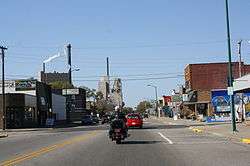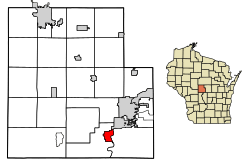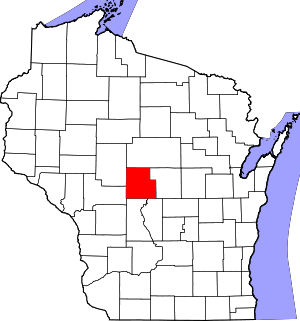Nekoosa, Wisconsin
Nekoosa is a city in Wood County, Wisconsin, United States. Its name derives from the Ho-Chunk word, "Nįįkuusra", "Nakrusa", or "Nįkusara" which translates to "running water."[6][7] The population was 2,580 at the 2010 census.
Nekoosa, Wisconsin | |
|---|---|
 Looking west in downtown Nekoosa | |
 Location of Nekoosa in Wood County, Wisconsin. | |
| Coordinates: 44°19′9″N 89°54′00″W | |
| Country | |
| State | |
| County | Wood |
| Government | |
| • Mayor | Daniel J. Carlson |
| Area | |
| • Total | 3.40 sq mi (8.81 km2) |
| • Land | 3.39 sq mi (8.79 km2) |
| • Water | 0.01 sq mi (0.03 km2) |
| Elevation | 951 ft (290 m) |
| Population | |
| • Total | 2,580 |
| • Estimate (2019)[4] | 2,422 |
| • Density | 713.82/sq mi (275.61/km2) |
| Time zone | UTC-6 (Central (CST)) |
| • Summer (DST) | UTC-5 (CDT) |
| ZIP codes | 54457 |
| Area code(s) | 715 & 534 |
| FIPS code | 55-55875[5] |
| GNIS feature ID | 1570148[2] |
| Website | www |
History
An article dated March 16, 1916 from the long defunct newspaper The Nekoosa Tribune detailing the early history of Nekoosa may be found at the Wisconsin Historical Society web site. It is a letter written by a resident to Nekoosa High School students to support them writing a history term paper.[8]
"Five rapids covering a distance of about three miles in this area were referred to as Nekoosa (swift water) by the Chippewa Indians, who made their campground on high Swallow Rock overlooking the rapids. Wakeley's tavern served as a rendezvous and resting place for the river traveler and lumber raftsman. Wakeley's was the nucleus for the development of a settlement named Point Basse (low point). The name was later changed to Nekoosa.
The settlement became a key town during the colorful era when lumber was rafted down the river from the pineries of the North to Mississippi River markets.
Daniel Whitney built the first sawmill on the Wisconsin River here at Whitney's Rapids in 1831 making Nekoosa the birthplace of Wood County. From this first harnessing of the river's power developed scores of power facilities making the Wisconsin River the hardest worked river in the world." [Point Basse historical marker, erected 1963][9]
Geography
Nekoosa is located at 44°19′09″N 89°54′00″W (44.319081, -89.899937).[10]
According to the United States Census Bureau, the city has a total area of 3.39 square miles (8.78 km2), of which, 3.38 square miles (8.75 km2) is land and 0.01 square miles (0.03 km2) is water.[11]
Demographics
| Historical population | |||
|---|---|---|---|
| Census | Pop. | %± | |
| 1900 | 745 | — | |
| 1910 | 1,570 | 110.7% | |
| 1920 | 1,639 | 4.4% | |
| 1930 | 2,005 | 22.3% | |
| 1940 | 2,212 | 10.3% | |
| 1950 | 2,352 | 6.3% | |
| 1960 | 2,515 | 6.9% | |
| 1970 | 2,409 | −4.2% | |
| 1980 | 2,519 | 4.6% | |
| 1990 | 2,557 | 1.5% | |
| 2000 | 2,590 | 1.3% | |
| 2010 | 2,580 | −0.4% | |
| Est. 2019 | 2,422 | [4] | −6.1% |
| U.S. Decennial Census[12] | |||
2010 census
As of the census[3] of 2010, there were 2,580 people, 1,065 households, and 688 families living in the city. The population density was 763.3 inhabitants per square mile (294.7/km2). There were 1,135 housing units at an average density of 335.8 per square mile (129.7/km2). The racial makeup of the city was 93.3% White, 0.8% African American, 1.4% Native American, 0.5% Asian, 1.8% from other races, and 2.2% from two or more races. Hispanic or Latino of any race were 3.4% of the population.
There were 1,065 households, of which 33.1% had children under the age of 18 living with them, 46.4% were married couples living together, 13.4% had a female householder with no husband present, 4.8% had a male householder with no wife present, and 35.4% were non-families. 30.2% of all households were made up of individuals, and 15.5% had someone living alone who was 65 years of age or older. The average household size was 2.40 and the average family size was 2.98.
The median age in the city was 39.4 years. 26.5% of residents were under the age of 18; 7.9% were between the ages of 18 and 24; 23.8% were from 25 to 44; 23.6% were from 45 to 64; and 18.1% were 65 years of age or older. The gender makeup of the city was 47.8% male and 52.2% female.
2000 census
As of the census[5] of 2000, there were 2,590 people, 987 households, and 702 families living in the city. The population density was 763.5 people per square mile (295.0/km2). There were 1,063 housing units at an average density of 313.4 per square mile (121.1/km2). The racial makeup of the city was 96.72% White, 0.12% African American, 1.27% Native American, 0.31% Asian, 0.97% from other races, and 0.62% from two or more races. Hispanic or Latino of any race were 1.81% of the population.
There were 987 households, out of which 36.3% had children under the age of 18 living with them, 55.2% were married couples living together, 12.9% had a female householder with no husband present, and 28.8% were non-families. 24.8% of all households were made up of individuals, and 13.3% had someone living alone who was 65 years of age or older. The average household size was 2.55 and the average family size was 3.05.
In the city, the population was spread out, with 27.6% under the age of 18, 7.8% from 18 to 24, 27.2% from 25 to 44, 20.6% from 45 to 64, and 16.8% who were 65 years of age or older. The median age was 37 years. For every 100 females, there were 88.6 males. For every 100 females age 18 and over, there were 83.5 males.
The median income for a household in the city was $39,375, and the median income for a family was $44,583. Males had a median income of $36,308 versus $22,361 for females. The per capita income for the city was $17,063. About 6.7% of families and 9.7% of the population were below the poverty line, including 10.6% of those under age 18 and 12.0% of those age 65 or over.
Economy
Employment in Nekoosa has long been dominated by paper making. The Nekoosa Paper Company, incorporated in 1893, constructed a mill on the Wisconsin River. In 1908 it merged with a paper company in nearby Port Edwards, forming the Nekoosa Edwards Paper Company, or NEPCO.[13][14] In 1970 NEPCO merged with the Great Northern Paper Company, forming Great Northern Nekoosa Corporation, or GNN, which was purchased in a hostile takeover by Georgia-Pacific in 1990.[15][16] In 2001 the mill was sold to Canadian paper company Domtar.[17][18][19]
The Nekoosa mill was the original home of a cutting-edge paper machine first shown at the 1893 Columbian Exhibition. The machine was moved in 1923 to a sister mill in Port Edwards.[20] Stock certificates from NEPCO[21][22] and GNN[23] are popular scripophily items.
Education
Nekoosa has four schools: Humke Elementary School, Alexander Middle School, Nekoosa High School, and Nekoosa Academy. A new school designed specifically to teach Ho-Chunk heritage and history has been added to the district.
Notable people
- Chief Oshkosh, Native American leader
- Ed 'Strangler' Lewis, professional wrestler
- Edgar Manske, professional football player
- Frederick C. Peerenboom, radio
- John M. Potter, Wisconsin State Senator
Images
 Looking south in downtown Nekoosa
Looking south in downtown Nekoosa Sign on WIS 73
Sign on WIS 73 Police station and water tower
Police station and water tower Post office
Post office
References
- "2019 U.S. Gazetteer Files". United States Census Bureau. Retrieved August 7, 2020.
- "US Board on Geographic Names". United States Geological Survey. 2007-10-25. Retrieved 2008-01-31.
- "U.S. Census website". United States Census Bureau. Retrieved 2012-11-18.
- "Population and Housing Unit Estimates". United States Census Bureau. May 24, 2020. Retrieved May 27, 2020.
- "U.S. Census website". United States Census Bureau. Retrieved 2008-01-31.
- "A history of the origin of the place names connected with the Chicago & North Western and Chicago, St. Paul, Minneapolis & Omaha railways", page 106, by William H. Stennett, Edition 2, Published 1908, Original from Harvard University, Digitized July 30, 2008 for Google Books, 201 pages.
- "Locations". Hoocąk Waaziija Haci Language Division, A Division of The Ho-Chunk Nation. Archived from the original on 2014-06-29. Retrieved 2014-04-06.
- "Nekoosa History". The Nekoosa Tribune. Retrieved 10 April 2011.
- Point Basse Marker
- "US Gazetteer files: 2010, 2000, and 1990". United States Census Bureau. 2011-02-12. Retrieved 2011-04-23.
- "US Gazetteer files 2010". United States Census Bureau. Archived from the original on 2012-01-24. Retrieved 2012-11-18.
- "Census of Population and Housing". Census.gov. Retrieved June 4, 2015.
- J. Marshall Buehler. The Nekoosa Story: A Commemorative History of Nekoosa Papers Inc., Port Edwards, Wis.: Nekoosa Papers, 1987. 169p. HD 9829 .N45 B84 1987.
- Wisconsin Historical Society entry for Lewis Miller Alexander (1858-1931)
- "Nekoosa seeks buyer to avoid hostile bid", New York Times, February 14, 1990.
- "Nekoosa to Weigh New $3.8-Billion Georgia-Pacific Bid - Takeovers: The paper products firm earlier rejected a $58-per-share offer. Now it will discuss a sweetened deal" LA Times, November 20, 1989
- Domtar corporate web site description
- "Great Northern Nekoosa Corporation", Lehman Brothers Collection
- Great Northern Nekoosa Corporation Stock Certificate & History
- The Beloit Iron Works Columbian Machine
- "Nekoosa-Edwards Paper Company Stock Certificate". Archived from the original on 2006-12-30. Retrieved 2009-10-23.
- Great Northern Nekoosa Corporation Stock Certificate
- "Great Northern Nekoosa Paper Corporation Stock Certificate". Archived from the original on 2009-08-27. Retrieved 2009-10-23.
External links
| Wikimedia Commons has media related to Nekoosa, Wisconsin. |
- City of Nekoosa official web site
- Nekoosa Public Schools
- Historic Pointe Basse
- Sanborn fire insurance maps: 1895 1902 1909
- Plat maps of Nekoosa: 1909 1928
